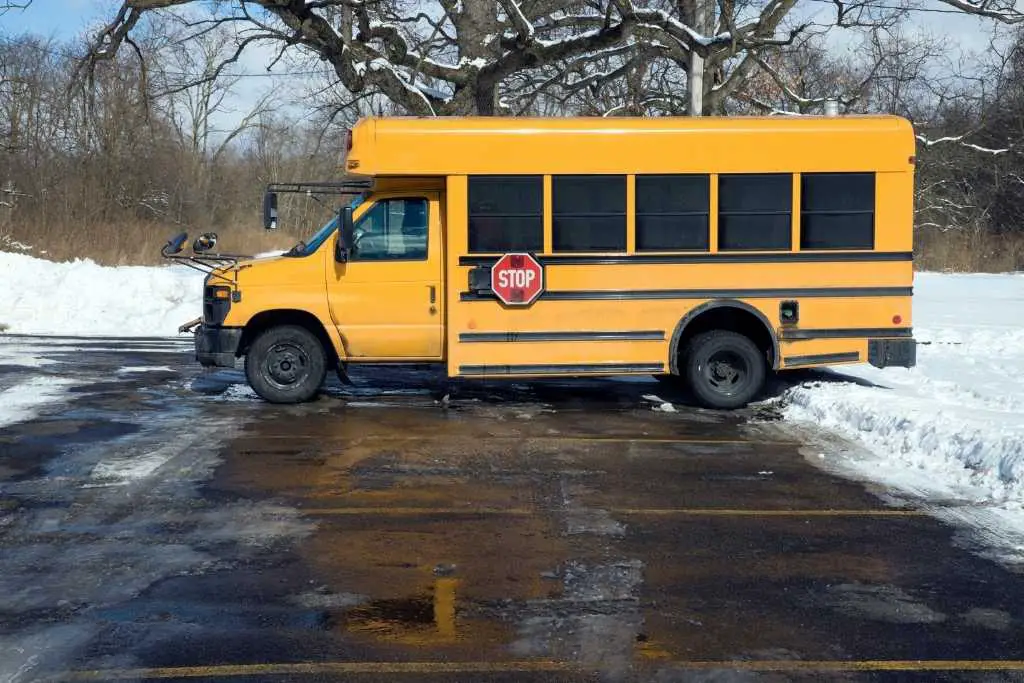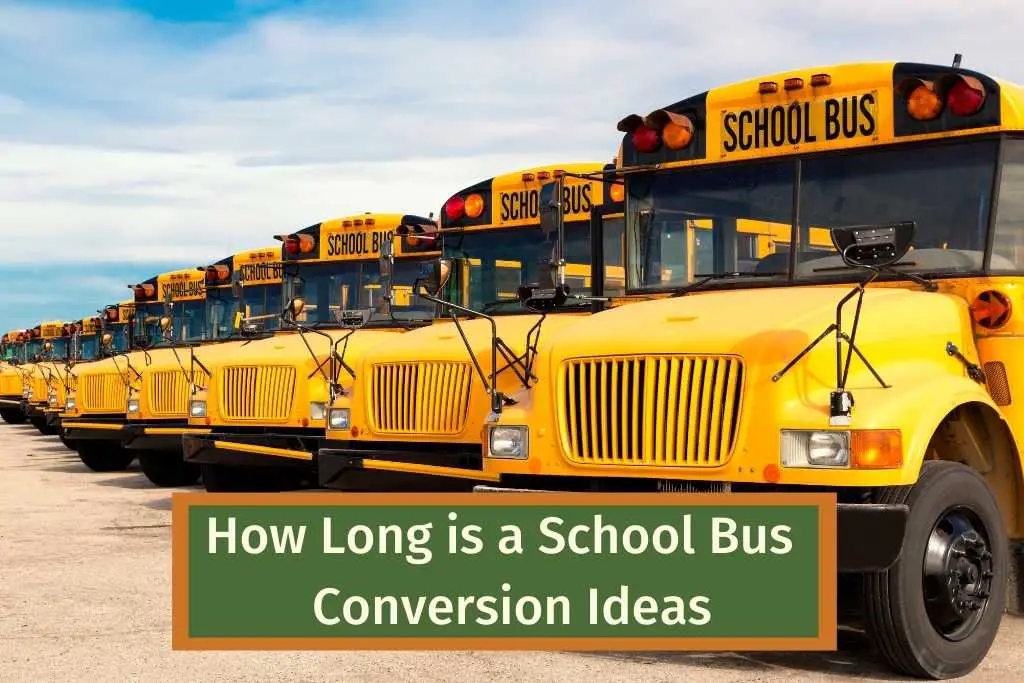Converting a school bus is a fantastic project, and will be well worth it when you have your perfect Skoolie conversion. But, before you start you will need to decide what length of school bus is right for you.
The problem is that school buses come in a wide variety of different sizes.
So, how long is a school bus? School buses come in four different sizes and range from 20 to 45 feet long, with the average length of 25 to 35 feet. School buses cannot be longer than 45 feet in Canada and USA. Type A buses are 20 to 25 foot, type B are 22 to 30 foot, type C are 25 to 35 foot and type D are 30 to 45 foot.
It’s important to know that they are not all the same size, you want to get the type of school bus that will best suit you and your conversion plans.
How long is a School bus?
There are four main types of school buses:
1- Type A Schoolbus- the smallest type (short bus)- 20-25 feet
2- Type B Schoolbus- small medium type – 22-30 feet
3- Type C Schoolbus- medium size, this size is the most common – 25-35 feet
4- Type D Schoolbus- largest type – 35-45 feet




Type A School Bus or Short Bus (20-25ft)



Type A school buses are a good option for solo travelers. They are based on a cutaway van chassis and so are compact, lightweight, and easy to drive.
Because they are small they can also fit into most parking spaces and are more maneuverable than the bigger skoolies. This means that you won’t need an extra car to run errands or go sightseeing in.
Unfortunately, there is a price to pay for the maneuverability, which is space. Converting a type A school bus will mean that you’ll have to compromise on amenities. You’re probably not going to have room for a bathroom or kitchenette.
Type B and C School Buses or Medium-Size Buses (22-35ft)
Types B and C are the most common size skoolies you’ll find in America, they are a good compromise between the small and large.
You will be able to add most amenities to a medium size school bus, and they are perfect for a couple. If you are feeling ambitious you could also squeeze in children and/or pets.
If you think a medium sized school bus is right for your conversion they you’ll want to get clever with your design to make the most out of the space
Most skoolie conversions are with medium size buses.
They are likely built on cowled medium-duty truck chassis, so they are fairly easy to drive and maneuver. You shouldn’t have any problems boondocking or getting into campsites etc. You might want to tow a car to enable you to run errands.
Type D School Bus or Full-Size Bus (35ft-45ft)
If space is your biggest priority then you can’t get much bigger than a type D skoolie, these buses have a capacity of up to 90 passengers.
This large bus will easily fit 3 or more people, and pets and children. You will have lots of room for your conversion and will easily fit a full kitchen and bathroom into the skoolie if you want.
You will have to tow a vehicle behind, so you can have some freedom when you have reached your destination.
As you might have guessed, you will be compromising on maneuverability with a type D bus. Driving these will definitely take some getting used to and finding parking will be a nightmare, especially in busy locations.
However, if you are planning on spending a lot of time in your skoolie conversion, or even living in it, this option will give you enough space to adjust.
How To Decide What School Bus Length is Right For You
To help you figure out which is the best length school bus for your conversion and lifestyle here are a few questions to ask yourself.
How long will you be spending in your Skoolie?
The size you want will depend on how long you will spending in your conversion. If you’re going full time you will want more space.
Are you going to be living in your skoolie conversion, part-timing or just using it for the odd trip?
How many people will be living on the bus?
This is the most obvious and important question, and will predominantly determine what size is best for you.
The more people then the bigger size bus you’ll need. Typically type A buses suit solo travellers, type B and C will suit couples, and type D will suit families.
You’ll also want to ask yourself how much space you think you’ll need. Do you want to have a separate space so you can have alone time, do you have enough space for the childrens toys or pet supplies?
Where will you be travelling to in your skoolie?
Like mentioned above the bigger the bus the harder it is to drive and maneuver – not to mention park.
Type A school buses won’t need much planning ahead, you can pretty much drive anywhere in it and park anywhere.
The bigger buses will need some planning and consideration, some sites may be off out of bounds due to limited access. Driving on narrow roads, busy tight streets, and off road will be increasingly difficult, the bigger the bus gets.
You’ll also want to consider a towing vehicle if you have a large bus. This will allow you to easily run errands and give you more freedom when you are on site.
Budget for your conversion
The cost of the school bus is in many ways the tip of the iceberg when it comes to school bus conversions.
As a rough guide the cost of a used school bus is as follows:
Type A – $6,000 to $8,000
Type B – $7,000 to $10,000
Type C – $7,000 to $10,000
Type D – $10,000 to $12,000
Obviously the condition of the bus will affect the price, and it’s worth getting a better condition/newer bus if your budget allows.
The conversion cost is entirely dependent on your budget, some great conversions have been done for as little as $4,000. Just remember to keep an eye on your conversion costs because they can quickly escalate.
Other Factors to Consider When Choosing School Bus to Convert
The Square Footage of the Bus
Just like buying property, you will want to know how much space you have to work with. Unfortunately, the sq ft isn’t commonly listed.
To get a rough square footage just times the length by the width, length x width = square footage
Where is the Engine Located?
School buses are either dognosed or flat, these different types will have their engine in different locations. Some buses will have the engine in the front and some will have it in the back. Make sure that you know how to access the engine for maintenance.
Where the engine is located will also affect the layout of the interior so bear this in mind when you are looking round.
Where Will You Convert Your School Bus?
Before you purchase a school bus for conversion, you will want to know where you can do the conversion. If you are lucky enough to own a home with a drive you will need to check HOA regulations as some places prohibit RVs on driveways and streets.
You will need an easy accessible, secure location to store the school bus whilst you are converting it.
How Long is a School Bus FAQs
What is the average length of a school bus?
The average length of a school bus in America is 25 to 35 foot.
How Buses Are Measured?
Buses are measured from front bumper to back bumper, this will give you the total length of the bus.
To measure the square footage of a bus multiply the width by the length, this will give you the area of the interior. However, there will be some areas that are unusable like the driver’s seat and wheel arches.
What is The Window Rule for Bus Length ?
If you need to measure a school bus, but don’t have a tape measure then you can get a rough estimate of the length by counting the windows.
Each window is about 2.5 feet wide so you can quickly multiply the number of windows by 2.5 and add 10 feet if the bus is dog nose or 6 feet if the bus is flat-nosed.
This will give you a rough estimate of the length of the bus.
Final Thoughts
Undertaking a school bus conversion is not for the faint of heart, but it can be a hugely rewarding experience.
The first step is picking the right sized school bus for your needs, I hope that this article has given you a better idea of the various school bus lengths that are available.


